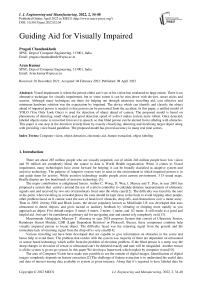Guiding Aid for Visually Impaired
Автор: Pragati Chandankhede, Arun Kumar
Журнал: International Journal of Engineering and Manufacturing @ijem
Статья в выпуске: 2 vol.12, 2022 года.
Бесплатный доступ
Visual impairment is where the person either can’t see or his vision has weakened to large extent. There is no alternative technique for visually impairment, but to some extent it can be trim down with devices, smart sticks and sensors. Although many techniques are there for helping out through electronic travelling aid, cost effective and minimum hardware solution was the expectation by impaired. The device which can identify and classify the object ahead of impaired person is needed so that person can be prevented from the accident. In this paper, a unified model of YOLO (You Only Look Once) is used for detection of object ahead of camera. The proposed model is based on phenomena of detecting small object and good detection speed of yolov3 makes system more robust. Once detected, labeled objects name is converted from text to speech, so that blind person can be alerted from colliding with obstacles. This paper is one step in the direction to help them by exactly classifying, detecting and localizing target object along with providing voice based guideline. The proposed model has proved accuracy in many real time scenes.
Computer vision, object detection, electronic aid, feature extraction, object labeling
Короткий адрес: https://sciup.org/15018297
IDR: 15018297 | DOI: 10.5815/ijem.2022.02.04
Список литературы Guiding Aid for Visually Impaired
- Karen Simonyan_ & Andrew Zisserman, “Very Deep Convolution Networks for Large-Scale Image Recognition” ICLR 2015.
- G. E. Hinton, N. Srivastava, A. Krizhevsky, I. Sutskever and R. R. Salakhutdinov, “Improving neural networks by preventing co-adaptation of feature detectors” , arxiv, 2012.
- Shraga Shoval, Johann Borenstein, and Yoram Koren, “Mobile Robot Obstacle Avoidance in a Computerized Travel Aid for the Blind” IEEE International Conference on Robotics and Automation, 1994.
- Shuihua Wang , Xiaodong Yang , Yingli Tian, “Detecting signage and doors for blind navigation and wayfinding” Network Modeling Analysis in Health Informatics and Bioinformatics , 2013.
- Filippo L.M. Milotta, Dario Allegra, Filippo Stanco, Giovanni M. Farinella “An Electronic Travel Aid to Assist Blind and Visually Impaired People to Avoid Obstacles” Springer International Publishing Switzerland. 2015.
- Ross Girshick, “Fast R-CNN”, IEEE International Conference on Computer Vision, 2015.
- Kaiming He, Xiangyu Zhang, Shaoqing Ren, Jian Sun,“Deep Residual Learning for Image Recognition” IEEE Conference on Computer Vision and Pattern Recognition (CVPR) 2016.
- Joseph Redmon Ali Farhadi , “YOLOv3: An Incremental Improvement” , arxiv , 2018.
- Fares Jalled, Ilia Voronkov “Object Detection Using Image Processing” , arxiv, 2016.
- Karen Simonyan, Andrew Zisserman, “Very Deep Convolution Network for Large Scale Image Recognition”, ICLR 2015.
- Piotr Dollár, Pietro Perona, Serge Belongie “The Fastest Pedestrian Detector in the West”, British Machine Vision Conference, 2010.
- C. Wong, D. Wee, I. Murray and T. Dias ,"A Novel design of Integrated Proximity Sensors for the White Cane" , The Seventh Australian and New Zealand Intelligent Information Systems Conference, 2001.
- Jeremy Hill and Black Jones, “The Miniguide: A New Electronic Travel Device”, Journal of Visual Impairment and Blindness, Volume 97 issue 10, 2003.
- Maymounah ALSHAJAJEER, Maryam Taqi Almousa, Qasem Abu Al-Haija, Journal of Applied Computer Science & Mathematics "Enhanced White Cane for Visually Impaired People" Issue 2, (Vol. 12), 2018.
- Htwe Pa Pa Win, Phyo Thu Thu Khine, Khin Nwe Ni Tun “Face Recognition System based on Convolution Neural Networks” International Journal of Image, Graphics and Signal Processing, MECS, 2021.
- Md. Rezwanul Haque, Md. Milon Islam, Kazi Saeed Alam, Hasib Iqbal, Md. Ebrahim Shaik “A Computer Vision based Lane Detection Approach” International Journal of Image, Graphics and Signal Processing, MECS, 2019.


